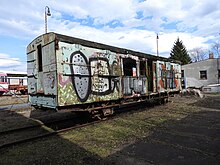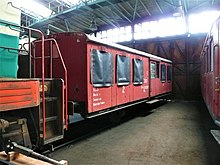ČSD series M 130.1
| ČSD series M 130.1 | |
|---|---|
| Numbering: | M 130.1001–1113 ČSD |
| Number: | 113 |
| Manufacturer: | Škoda , Plzeň |
| Year of construction (s): | 1932-1939 |
| Retirement: | until 1962 |
| Axis formula : | A1 |
| Gauge : | 1435 mm ( standard gauge ) |
| Length over buffers: | 10,650 mm |
| Length: | 9,650 mm |
| Height: | 4,000 mm |
| Width: | 2,500 mm |
| Total wheelbase: | 01-25: 5,300 mm 26-60: 5,600 mm 61-113: 5,600 mm |
| Smallest bef. Radius: | 150 m |
| Empty mass: | 01-25: 13.2 t 26-60: 13.6 t 61-113: 13.7 t |
| Service mass: | 01-25: 16.3 t 26-60: 17.4 t 61-113: 17.5 t |
| Friction mass: | 8.4 t |
| Top speed: | 65 km / h |
| Installed capacity: | 01-25: 100 HP 26-113: 120 HP |
| Driving wheel diameter: | 850 mm |
| Wheel diameter: | 850 mm |
| Motor type: | 6 cylinder petrol engine |
| Rated speed: | 01-25: 1400 / min 26-113: 1600 / min |
| Power transmission: | mechanically |
| Tank capacity: | 316 l |
| Seats: | 38 |
| Floor height: | 900 mm |
| Classes : | 3. |
The former Czechoslovak State Railways ČSD designated two-axle motorized multiple units for traffic on main and branch lines as the M 130.1 series .
history
After the success of the two-axle tower cars from Tatra Kopřivnice , Škoda in Plzeň developed corresponding vehicles for the ČSD. In addition to the diesel-electric powered vehicles of the ČSD series M 222.0 , Škoda manufactured a type with an underfloor gasoline engine, mechanical power transmission and central entry, which the ČSD classified as M 130.1. In the years 1932–1939 a total of 113 railcars in two series were delivered to the ČSD.
After 1945, ten railcars were repowered by Tatra with new diesel engines.
With the commissioning of the new M 131.1 series railcars , the vehicles gradually became superfluous. By 1959, the last railcars with the still original petrol engine were eliminated. In 1962 the last modernized vehicle was taken out of service in Kralupy nad Vltavou . Numerous car bodies have been preserved in different states after being taken out of service.
The M 130.104 can look forward to being rebuilt as a rollable exhibit soon. After a long period of use as an arbor, the vehicle was recovered in 2018 by the railway enthusiasts in Pardubice and is now looking forward to being refurbished in the Pardubice depot. When the vehicle was recovered, it turned out that the drive was still there, and the vehicle was also one of the first vehicles built with a center entry. The railcar was manufactured by Škoda in 1933 under the serial number 27. The car body was delivered by Ringhoffer under the number 12321/1932. After its test on January 30, 1933, the car was always based in Kralup on the Vltava river. On December 21, 1951 it was taken out of service and then converted to the Clm 4-5863 sidecar
technical features


The railcars were equipped with an underfloor, water-cooled six-cylinder gasoline engine from Škoda. The vehicles modernized after 1945 received the twelve-cylinder T 301 diesel engine from Tatra. As was common in railcar construction back then, the radiators were arranged on the roof. They used the airstream for cooling.
A transmission from the automotive industry was used for power transmission, one axle was driven. The first 25 pieces had a special gear for changing the direction of travel.
The first 60-piece series had a center entry similar to the Tatra tower railcars, these were supplied by the Ringhoffer works . In these vehicles, the drive motor was located under the floor in the entry area. A double bench in the longitudinal direction for 8 seats concealed the drive motor protruding into the passenger compartment. In this variant, the Lokfünrer was not separated from the passenger compartment by any partition. He also had the toilet opposite the driver's seat in one direction of travel. From the M 130.161 onwards, the car bodies were manufactured by Tatra Kolín . The entrances to the end platforms were relocated. In this variant, the train driver was separated from the passengers by a compartment door, and the train driver's cab could be locked with the driver's seat using a special construction.
commitment
Because of their high performance, the railcars were preferred on routes in the mountains. Among other things, they ran from 1933 on the Slovak cog railway line Tisovec – Pohronska Polhora , where slopes of up to 50 per thousand had to be overcome.
See also
literature
- Bek Jindrich, Janata Josef, Veverka Jaroslav: Malý atlas lokomotiv 2, Elektrická a motorová trakce, Nadas Publishing House Prague
- Ing.Jan Urban Motory Vuz rady M 130.101 to 160 Železničář magazine, year 1983 (Czech)
- Authors' collective Motore vozy ze Škodovky, 2004, spolek Lokalka Group Rokycany
Web links
- Description (Czech)
- Website of the Pňovany – Bezdružice railway line with the M 130.187 multiple unit with a terminal entry
- Picture of the driver's cab of an M 130.1 with end entry, source: www.k-report.net
- Company photo of an M 130.1 from 1946, posted on www.k-report.net
Individual evidence
- ↑ Autorenkollektiv motors vozy ze Škodovky, 2004 spolek Lokálka Group Rokycany Page 32
- ↑ Photos of various preserved car bodies with end driver's cab on k-report
- ^ Website about the recovery of the M 130.104 on the website of the Railway Friends in Pardubice
- ↑ Contributions from various senders about the M 130.104 on k-report
- ↑ a b Autorenkollektiv motors vozy ze Škodovky, 2004 spolek Lokálka Group Rokycany page 29
- ↑ Author collective Motore vozy ze Škodovky, 2004, spolek Lokalka Group Rokycany, page 39
- ↑ Author collective Motore vozy ze Škodovky, 2004, spolek Lokalka Group Rokycany, page 36
- ↑ Autorenkollektiv motors vozy ze Škodovky, 2004 spolek Lokálka Group Rokycany Page 37
- ↑ Picture of the driver's cab of an M 130.1 with final entry, source: www.k-report.net